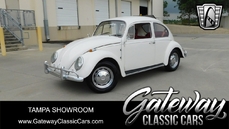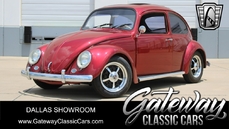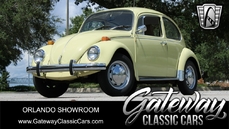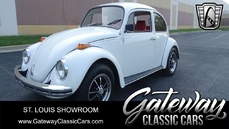Volkswagen Bubbla Typ1 Sedan 1949
Allmän beskrivning :
It could easily be argued that the Volkswagen Beetle (officially designated the Type 1) is the most popular and most recognizable car ever produced. Like the Ford Model T before it, the Volkswagen put a nation (and the world) on wheels thanks to its low cost and elegant mechanical simplicity. Despite its somewhat dubious roots within the Third Reich, the VW Beetle proved immensely popular in the post war years, particularly in a recovering Europe. In the US market, this funny little rear-engine car took some time to catch on, but once it did, it became immersed in popular culture, particularly through the 1960s. Many great mechanics and race car builders got their start tinkering with Beetles thanks to their simplicity, ease of service and surprising potential. A staggering 21.5 million examples were built between 1938 and 2003, becoming the longest running, highest selling, single-platform vehicle in history. From the first car to the last, changes were made not for the sake of change but always with the purpose of improvement and refinement.
1949 marked a major milestone for VW, as the year the very first Beetle was imported to the US market by the daring and brilliant Max Hoffman. Max Hoffman Imports had a bustling showroom in New York, and he was one of the most influential players in the European motoring industry, responsible for translating American tastes to European companies, along the way ensuring the success of companies like BMW, Alfa Romeo, Mercedes-Benz and Porsche established themselves in the fickle American marketplace.
While the Beetles of the 60s and 70s are most familiar to the general public, it is the cars built in the 1950s and earlier that attract the most attention from serious collectors and enthusiasts. They are considered the purest of form, and are also among the rarest given the lower production numbers and high attrition rate. True to the original design by Dr. Porsche, the shape is subtle yet complex, with form following function in a classic Teutonic manner. The earliest years of Volkswagen production were limited, with production truly gearing up after WWII was over and Germany was in recovery.
This 1949 Volkswagen Type 1 is a beautifully and recently restored example finished true to original specification. The body is outstanding, with lovely Pearl Grey paint laid down over excellent panels. Decklids fit beautifully and the doors shut solidly with excellent gaps. It has a wonderful, simple charm to it, and the paint work is expertly finished, carefully executed to not appear too glossy but with a period appropriate sheen that lends the car a factory-fresh appearance. The bumpers are excellent, as are lamp bezels on the correct Bosch lenses. Plain, painted steel wheels wear blackwall tires and simple chrome hub caps emblazoned with the VW logo. Semaphores in the B-pillars harken back to the car’s prewar roots and the distinct lack of trim and brightwork recalls the VW’s singular purpose as the car of the people.
Charming simplicity continues inside where the accommodations are about as basic as you can get, however the impeccable quality of the restoration shines through in expertly fit fabric seat upholstery and fine quality detailing front and rear. Kick panels and sills are covered in German squareweave carpet and the floors lined in fluted rubber mat. The dash is about as uncomplicated as you can get, housing a speedometer, glovebox and little else. What switchgear there is (for headlamps, wipers and turn signals) is correct. The cabin is the perfect antithesis to today’s needlessly complex automobiles that are full of distractions; this is a tool for driving, something you use to get from point to point as efficiently as possible, and yet the VW accomplishes its purpose in such an endearing way.
A correct 1131 cc horizontally opposed four cylinder sits out behind the rear axle line. The engine number (1-0135937) corresponds with both the chassis and serial numbers on the data tag and stampings in the body. The engine is carefully and properly detailed with period appropriate parts such as the brown-top Bosch coil and distributor cap, and black lacquered ignition leads. Engine sheet metal is beautifully restored and painted in a semi-gloss black as correct. It is exceptionally clean and tidy, showing almost no use since the restoration.
This is a beautifully presented Beetle; a highly desirable example from the early days of this iconic machine and a pure, simple joy to drive. This example’s fresh and immaculately prepared restoration make it immediately ready for show and enjoyment.
https://hymanltd.com/vehicles/5872-1949-volkswagen-beetle-sedan/
1949 Volkswagen Bubbla Typ1 Sedan is listed såld on ClassicDigest in St. Louis by Mark Hyman for $69500.
Fakta i bilen
Karosstyp : Personbil Märke : Volkswagen Modell : Bubbla Typ1 Modellversion : Sedan Motorvolym : 0.0 Årsmodell : 1949 Karosstyp : Sedan Läge : Missouri
Såld
Information om säljaren
Såld
People who viewed this Volkswagen Bubbla Typ1 also viewed similar Volkswagen listed at ClassicDigest
Other cars listed for sale by this dealer
om Volkswagen
Volkswagen-berättelsen är verkligen en spännande berättelse om innovation, motståndskraft och efterkrigstidens väckelse, präglat av olika modeller som har blivit ikoniska i bilhistoria.People's Car (Volkswagen): Ursprungligen föreställt av Adolf Hitler på 1930 -talet som en "folks bil" eller "Volkswagen" på tyska, var tanken att skapa ett prisvärt och praktiskt fordon för det tyska. Detta koncept ledde till utvecklingen av Volkswagen Beetle (eller typ 1), designad av Ferdinand Porsche.
Efterkrigstidens utmaningar: Efter andra världskriget mötte Volkswagen betydande utmaningar. Fabriken skadades kraftigt, och varumärkets förening med den nazistiska regimen ledde till brist på intresse i bilen i vissa regioner.
Brittisk intervention - Den brittiska armén & Ivan Hirst: Den brittiska armén tog kontrollen över fabriken under den omedelbara efterkrigstiden. Major Ivan Hirst, en brittisk arméoffiser, spelade en avgörande roll för att återuppliva Volkswagen. Han erkände potentialen i skalbaggen och förespråkade för dess produktion och övertygade den brittiska militären att beställa flera tusen bilar. Detta beslut hjälpte till att starta varumärkets väckelse.
Exportframgång och Beetle's Global Appeal: The Beetle fick popularitet inte bara i Tyskland utan också globalt och blev en ikon för prisvärd bil. Dess enkla, pålitliga design och unika utseende gjorde det till en favorit bland konsumenterna över hela världen.
Modell Evolution: Under åren introducerade Volkswagen olika modeller tillsammans med skalbaggen, var och en bidrog till varumärkets tillväxt:
Typ 2 (VW -buss eller transportör): Introducerad på 1950 -talet blev det en ikonisk symbol för hippie -rörelsen på 1960 -talet, älskad för sin rymlighet och mångsidighet.
Golf (kanin i USA): Lanserat i mitten av 1970-talet markerade golfen (eller kaninen i USA) en förskjutning mot framhjulsdrivna, moderna design och hatchback-praktik och blev en hörnsten i varumärkets framgång.
Passat, Jetta och andra modeller: Volkswagen utvidgade sin sortiment med modeller som Passat och Jetta, som catering till olika marknadssegment.
Utmaningar och innovationer: Trots framgång mötte Volkswagen utmaningar, inklusive kvalitetsfrågor på 1970 -talet. Varumärket fortsatte dock att förnya och utveckla nya modeller och tekniker.
Rise of the GTI och Global Expansion: 1980-talet såg ökningen av den ikoniska Golf GTI, en högpresterande version som ledde till den heta lucktrenden. Volkswagen utökade också sin globala närvaro under denna period.
Det brittiska ingripandet i att återuppliva Volkswagen efter andra världskriget spelade en viktig roll i varumärkets återupplivning. Även om det kan ha varit några spänningar eller konkurrens mellan bilföretag på 1950- och 1960-talet på grund av Volkswagens framgång efter kriget, stärkte varumärkets förmåga att producera innovativa och populära modeller sin plats i bilhistoria.











